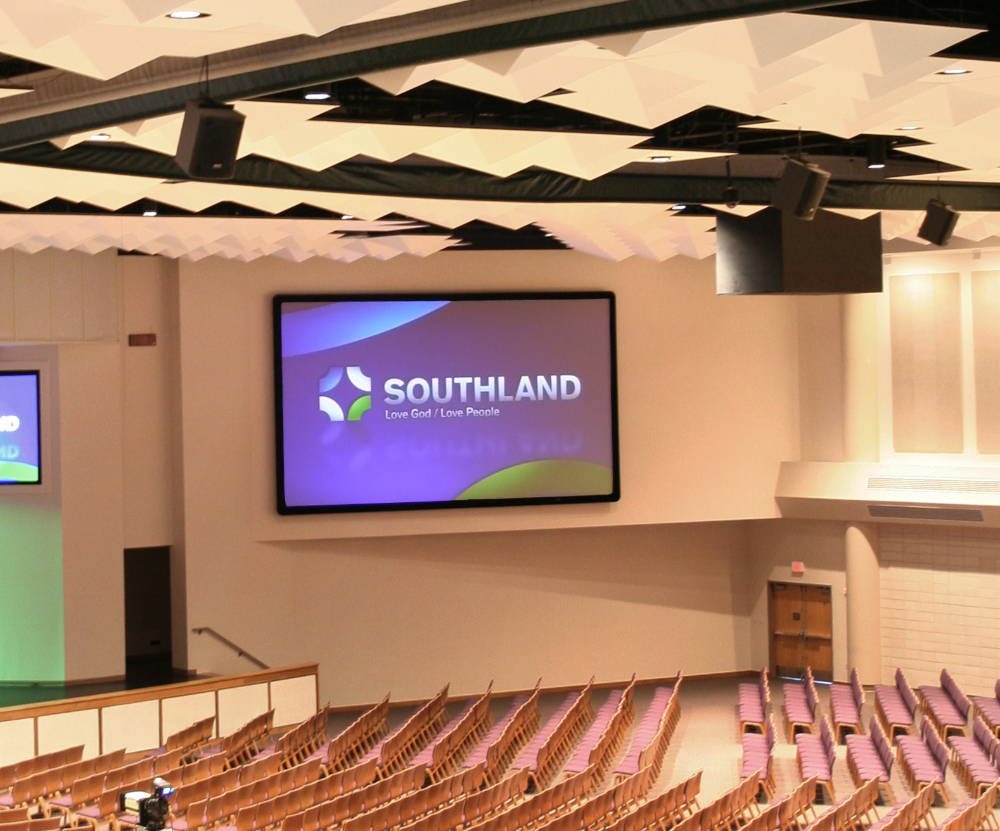I regularly read forum posts on ProSoundWeb questioning the necessity of adding delay loudspeakers to sound reinforcement systems.
The default argument in favor of them appears to be level restoration, while the default objections are budget, sightlines, timing issues, distortion of the sonic perspective, logistics, and labor. However, there’s a serious but often overlooked advantage of deploying delay loudspeakers, bordering the effectiveness of absorption, that go beyond plain level restoration.
The venue shown in Figure 1 originates from an actual PSW post and is a small house of worship. The person who posted it was seeking input from the forum community regarding the best approach for designing a suitable sound system with limited means.
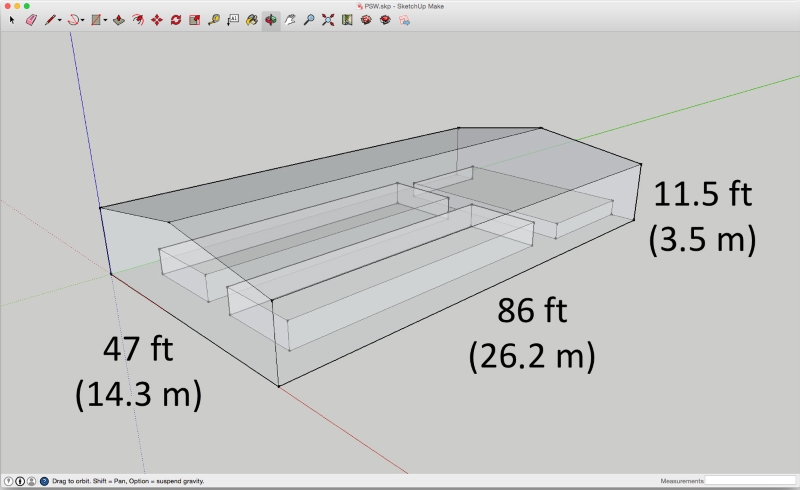
The walls and ceiling of the venue in Figure 1 are constructed of drywall (a.k.a., gypsum or Sheetrock) offering little to no mid- and high-frequency absorption. The stage and floor are covered with carpet. Typically, larger room volumes result in longer reverberation times unless the increase in size is accounted for by adding extra absorption. In this case. the volume is sufficiently small enough to get away with low absorption. And that doesn’t even consider the typically beneficial effects of audience absorption.
That said, audience members sitting near low absorbent boundaries at moderate to far distances to a sound system are expected to suffer from strong reflections at near identical levels. If direct (as the crow flies) and reflected trajectories approach each other in path length, relative level offsets decrease and the frequency response ripple inherent to comb filtering becomes worse. Each time direct and indirect cancel each other out, all that’s left is background noise. Signal-to-noise (SNR) ratios degrade and intelligibility suffers.
There are three common ways to deal with this:
- Steer clear of the offending boundaries with the main system by aiming the loudspeakers differently, and without missing the very audience members we’re trying to serve who are located just in front or next to said boundaries. In practice, this presents a conflict of interest and is virtually impossible, especially at low angles of incidence.
- If we can’t avoid striking those boundaries, then absorb or scatter the sound on impact. Either approach will probably affect cosmetics in some way and is also likely to change the acoustics of the venue, which might be at odds with other applications like unamplified events that benefit from a certain amount of natural amplification and reverberation.
- 3) Deploy delay loudspeakers and exploit their directional properties by careful positioning and aiming in an attempt to effectively “bypass” boundaries. Before we look at the latter, let’s start by considering the default argument in favor of delay loudspeakers, namely level restoration.
Coming Up Short
A section view of the venue (Figure 2) shows a 5.6:1 range ratio (15 dB of level variance from front to back) for a loudspeaker placed downstage at the “highest” possible position. A single loudspeaker, however, can only correct a range ratio of 2:1 at most (from on-axis at 100 percent relative distance to off-axis 50 percent closer). Even if we’re willing to accept 6 dB level variance, this leaves us 3 dB short at the back of the audience.

At least four to five loudspeakers configured in an asymmetrical coupled point source or a “dash” array (a line array of six loudspeakers or less) would be required to deal with this kind of asymmetry in the vertical plane. Both solutions are beyond the scope of this article, as well as the available real estate and budget.
Another disadvantage of a single loudspeaker/main-only approach is tonal variance. The low-frequency transducer of a typical loudspeaker is incapable of introducing any directivity because it’s producing wavelengths that exceed its own diameter several times, rendering it immune to rotation. This is contrary to the mid and high frequencies, which can be controlled very well by a proper constant directivity horn, allowing us to direct the sound where we want it to go.
Use Front Fills
Figure 3 shows a single 50-degree loudspeaker aimed at the rear of the room. The front to back level drop in this part of the spectrum is 9 dB (15 dB of range minus 6 dB of angular attenuation), and it’s overshooting the beginning of the audience. The latter issue affects only a minority of the audience and is best dealt with by a local solution, e.g., front fills.

Figure 4 depicts the low end of the same loudspeaker. Its lack of directivity and inherent immunity to rotation result in a 15 dB loss. There’s only distance at play and no angular attenuation because there’s no coverage angle to begin with in this part of the spectrum. Room gain favoring low frequencies, by accumulated reflections over distance (also known as LF buildup), is likely to decelerate the LF loss rate.

That being said, if left unaccounted for, different loss rates result in tonal variance. Should the result in the back of the venue be too dark (the rule and not the exception) because we simultaneously suffered from HF losses by air, the delay loudspeaker provides an additional bonus by restoring only those frequencies that are missing. This reduces the spectral tilt. Just be mindful that the hi-hat can’t be traced back to the delay loudspeaker, focusing attention on its location.
On The Plus Side
Regardless, level restoration of at least 3 dB in the rear of the room is required, the most common argument in favor of a delay loudspeaker, in order to place the entire audience within 6 dB of level variance or less. Figure 5 offers a section view of this approach. The mains have been titled slightly down to limit their coverage to a 2:1 range ratio, reaching all the way down to the second row. A delay loudspeaker will take care of the remainder of the audience, piggyback-riding on the mains.

Figure 6 demonstrates the essence of this article and the often overlooked necessity of delay loudspeakers if re-aiming or absorption is not a viable solution. A single loudspeaker at a grazing angle of incidence, placing the audience in or near the propagation plane with respect to its reflected sound of a non-absorbent rear wall, can only maintain its level dominance in the first half of the audience.
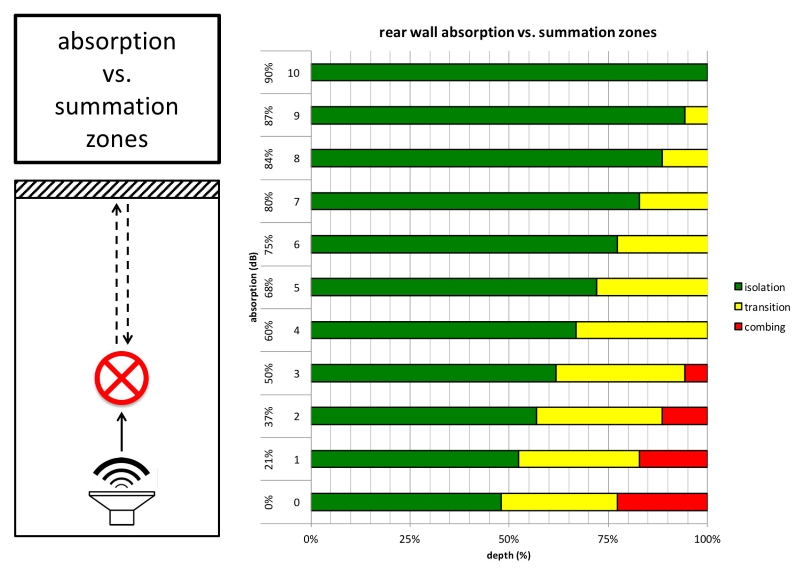
Beyond that milestone, path lengths approach each other, resulting in strong reflections. We can’t expect the main loudspeaker to reach the last row and magically avoid the rear wall. When we get closer to the rear wall its presence increases. On our dual-channel FFT analyzer, this will manifest itself as a decrease in coherence (Figure 7), a metric for SNR.
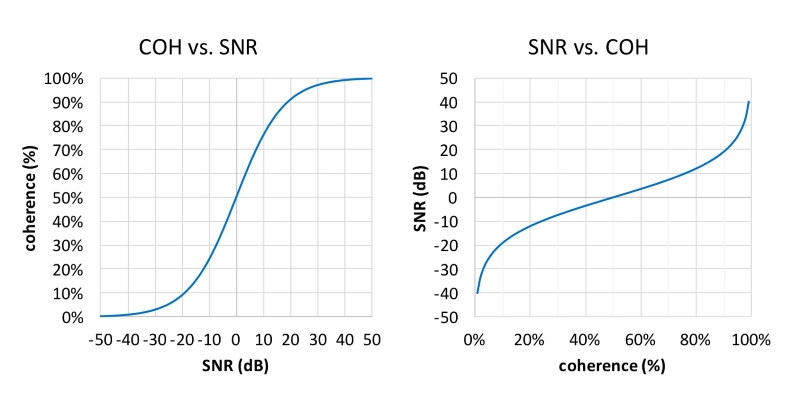
Contrary, the forward-positioned delay loudspeaker has a considerably different geometrical relation to that very same rear wall. Its increased down-tilt angle enters angular attenuation into the off-axis reflected path (Figure 8). The reflected trajectory traveled a longer distance compared to the direct sound and on top of that suffered an additional penalty at the start.
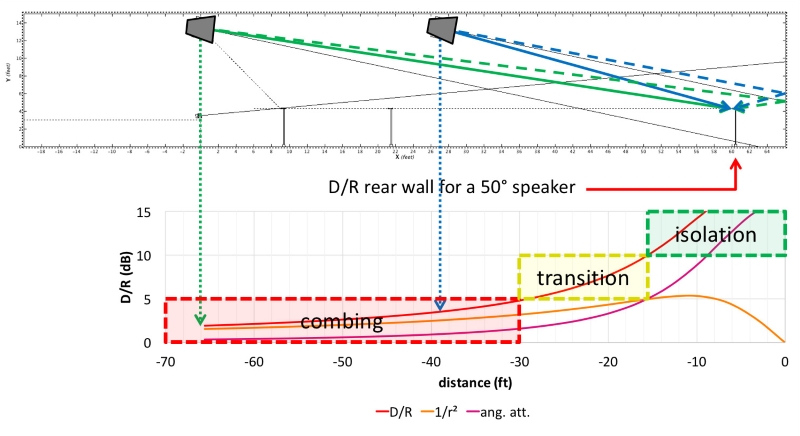
Therefore, the delay loudspeaker will exhibit improved D/R (direct-to-reverberant ratio) that benefits the compromised main loudspeaker while simultaneously restoring level and reducing tonal variance.
The angle of incidence of the delay loudspeaker with respect to the main loudspeaker will determine the rate at which main and delay tear apart in terms of time (Figure 9). Evidently a properly delayed delay loudspeaker placed in-line with the main speaker will remain time aligned over distance, while delay and main opposing each other will create a stalemate situation.
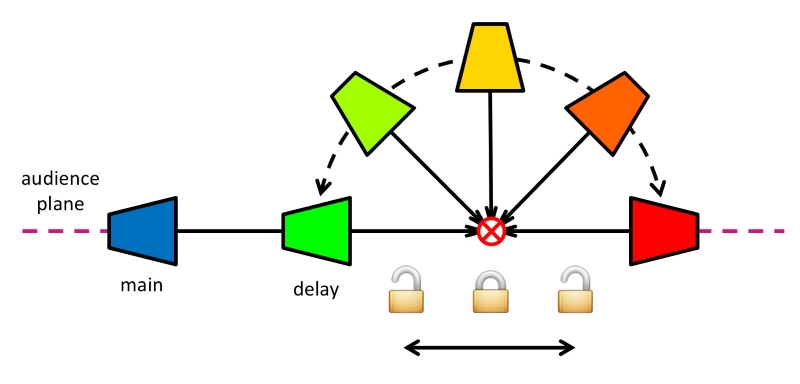
When choosing the correct position for the delay loudspeaker(s), the coverage, level and tonal variance should be carefully balanced against the improved D/R of a more forward position in exchange for reduced “synchronicity.” If room treatment is not an option (again, Figure 6), then delay loudspeakers are a viable alternative for improving D/R in the most vulnerable part of the audience.
Rules Of Thumb
To insure that the output of the delay loudspeaker is as inconspicuous as possible, make sure:
- It is equally loud as the main, at most.
- It arrives on time. The Haas (or precedence) effect requires a differential system to detect an offset in arrival times. A system we do not possess in the vertical plane contrary to the horizontal plane. Over-delaying will result in an audible and measurable degradation, less efficiency, and artifacts ranging from strong tonal coloration to possibly discrete echoes, depending on the program material. DISCLAIMER: If big temperature swings are to be expected, affecting the sound speed and consequentially time alignment, delay times must be revaluated. If temperature swings can’t be accounted for, the relay line offers better trade-offs.
- It sounds the same. Typically, there is way less air between delay loudspeakers and the audience than there is between the main(s) and the audience. The main loudspeaker has suffered a bigger HF penalty than the delay loudspeaker. The latter, therefore, should be made equally dark. Alternatively, the output of the main could be made brighter as long as it doesn’t make things worse in the front of the audience.
- The low-end is shelved or ultimately even cut. Most mains will have suffered a substantial amount of low-frequency buildup in the back of room. Shelving out some low end in the delay loudspeaker will reduce tonal variance and simultaneously reduce LF backwash for the audience in front of the delay loudspeaker. Figures 10 and 11 show the differences between both approaches with boundaries enabled. Notice the reduced comb filter in the back of the audience.
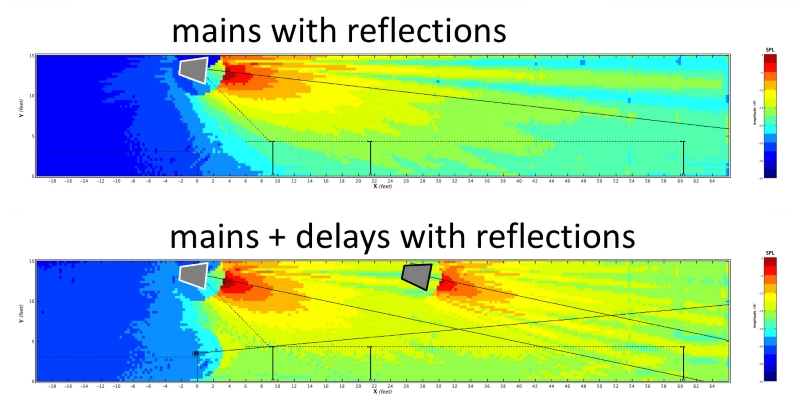
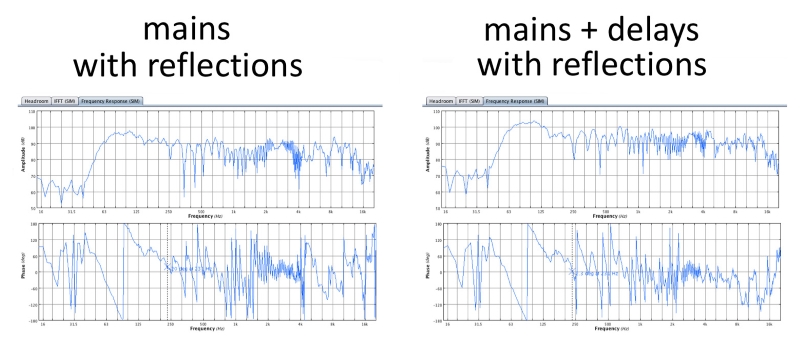
In conclusion, properly deployed delay loudspeakers will:
- Restore level (which isn’t always required)
- Decrease tonal variance
- Improve D/R
- Reduce comb filtering
- Improve SNR, coherence, and intelligibility

